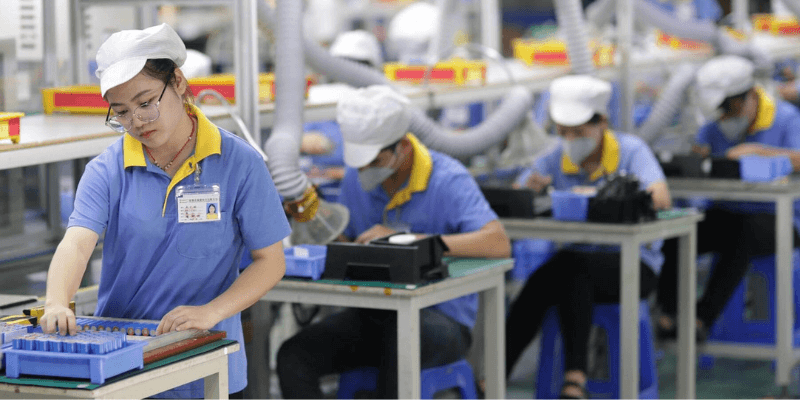แบตเตอรี่ลิเธียมให้พลังงานแก่สมาร์ทโฟนยานพาหนะไฟฟ้าและอื่น ๆ หากไม่มีเทคโนโลยีนี้เราจะถูกผูกไว้กับร้านค้า
ในบทความนี้เราจะอธิบายว่าแบตเตอรี่ลิเธียมทำอย่างไรครอบคลุมวัสดุ การผลิตและกระบวนการประกอบ
แบตเตอรี่ลิเธียมไอออนคืออะไร?
แบตเตอรี่ลิเธียมไอออนเป็นแหล่งพลังงานแบบชาร์จไฟได้ซึ่งใช้ลิเธียมไอออนเพื่อสร้างแรงดันไฟฟ้า พวกเขาเป็นหนึ่งในตัวเลือกแบตเตอรี่แบบชาร์จไฟที่ชาร์จไฟได้มากที่สุด
แบตเตอรี่ลิเธียมหกชนิดที่แตกต่างกัน มีอยู่. ที่ Holo Battery เราใช้เคมี NCM และ LIFEPO4 เป็นหลัก
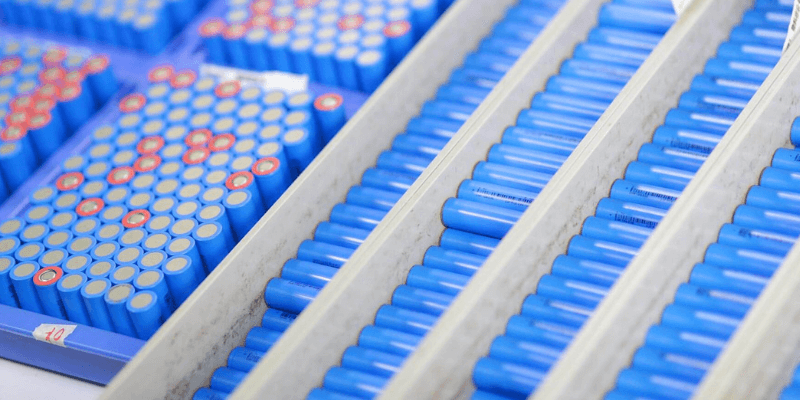
วัสดุอะไรที่จำเป็นในการทำแบตเตอรี่ลิเธียม?
แบตเตอรี่ลิเธียมส่วนใหญ่ประกอบด้วยวัสดุต่อไปนี้:
เซลล์แบตเตอรี่ลิเธียม
แบตเตอรี่ลิเธียมในระบบสุริยจักรวาล EVs และ RVs ทำจากเซลล์แต่ละเซลล์ขนาดเล็กจำนวนมากแต่ละเซลล์มี ขั้วบวกแคโทด, และ อิเล็กโทรไลต์- ผู้ผลิตเชื่อมโยงเซลล์เหล่านี้เข้าด้วยกันเพื่อสร้างกำลังไฟที่ต้องการ
แบตเตอรี่สร้างพลังงานเมื่ออิเล็กตรอนเคลื่อนที่จากขั้วบวกผ่านอิเล็กโทรไลต์ไปยังแคโทด ขั้วบวกเป็นโลหะออกซิไดซ์และแคโทดมักจะเป็นลิเธียมออกไซด์ อิเล็กโทรไลต์ซึ่งเป็นสารละลายเกลือลิเธียมจัดหาอิเล็กตรอนส่วนเกินเพื่อให้แบตเตอรี่ทำงานได้
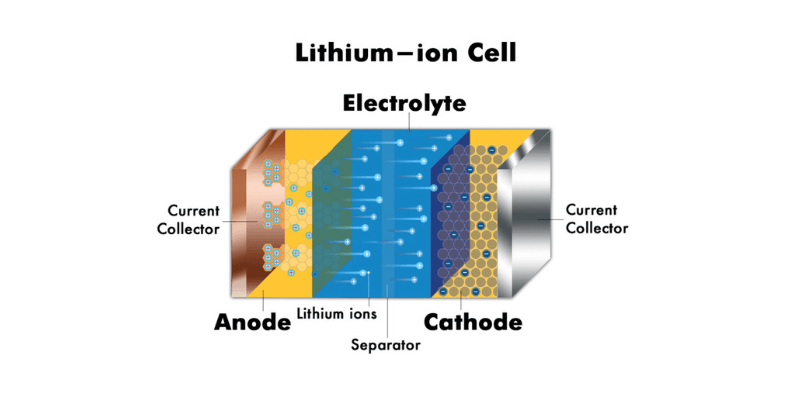
อุปกรณ์อิเล็กทรอนิกส์และส่วนประกอบ
เซลล์แบตเตอรี่แต่ละเซลล์เชื่อมต่อกับชุดแบตเตอรี่ที่มีขนาดใหญ่กว่าและทรงพลังกว่าผ่านสายไฟและ ขั้ว- เซลล์’ การเชื่อมโยงปลายบวกและลบผ่านส่วนประกอบทองแดงและอลูมิเนียมช่วยให้อิเล็กตรอนไหลได้อย่างราบรื่น
แต่ละชุดแบตเตอรี่ยังมี ระบบการจัดการแบตเตอรี่ (BMS) นั่นจะตรวจสอบอุณหภูมิของแพ็คและการชาร์จ/การปลดปล่อยของแต่ละเซลล์
ตัวเรือนแบตเตอรี่
ตัวเรือนแบตเตอรี่เป็นองค์ประกอบที่สำคัญ – ช่วยปกป้องแบตเตอรี่จากการสัมผัสกับองค์ประกอบภายนอกที่อาจรบกวนการทำงานของแบตเตอรี่ วัสดุคอมโพสิตมีน้ำหนักเบาและทนต่อไฟไหม้ความเสียหายจากการชนและการกัดกร่อน
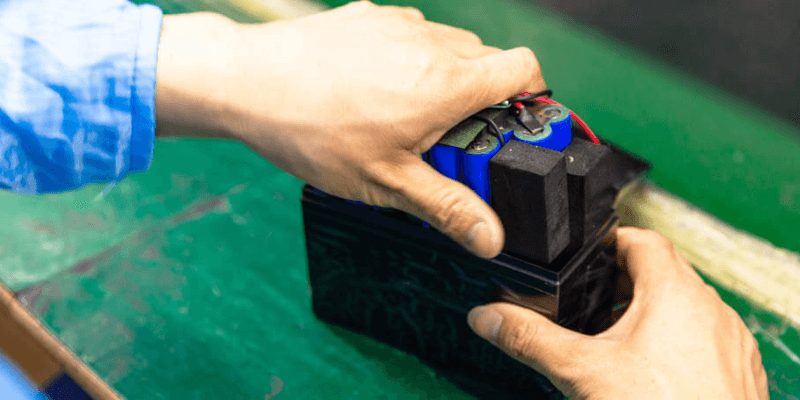
แบตเตอรี่ลิเธียมผลิตขึ้นมาได้อย่างไร?
กระบวนการผลิตแบตเตอรี่ลิเธียมนั้นเข้มงวดตั้งแต่การผลิตเซลล์ไปจนถึงชุดแบตเตอรี่เพื่อความปลอดภัยและความน่าเชื่อถือ
การผลิตเซลล์
เซลล์แบตเตอรี่ลิเธียมผลิตผ่านชุดของขั้นตอน:
1. การเตรียมวัสดุ: วัตถุดิบ (วัสดุแคโทดและขั้วบวก, อิเล็กโทรไลต์, ตัวแยก ฯลฯ ) จำเป็นต้องมีการเตรียมและการประมวลผลก่อนผสม สิ่งนี้เกี่ยวข้องกับขั้นตอนต่าง ๆ เช่นการทำให้บริสุทธิ์การบดและการเผา
2. การผสม: วัสดุที่ใช้งานสารเติมแต่งนำไฟฟ้าสารยึดเกาะและตัวทำละลายรวมกันเพื่อสร้างสารละลาย
3. การเคลือบ: สารละลายถูกเคลือบลงบนฟอยล์คอลเลคเตอร์ปัจจุบันและทำให้แห้งเพื่อสร้างอิเล็กโทรดที่มีรูพรุน
4. การตัด: อิเล็กโทรดที่เคลือบจะถูกตัดเป็นชิ้นโดยใช้เครื่องสลิงลูกกลิ้ง
5. การสแต็คหรือการคดเคี้ยว: ขั้วบวกแคโทดและตัวคั่นจะถูกซ้อนกันหรือแผลเป็นเกลียวขึ้นอยู่กับชนิดของแบตเตอรี่
6. การทำเครื่องหมาย: ด้านบวกและลบถูกทำเครื่องหมาย
7. การฉีดอิเล็กโทรไลต์: สารละลายเกลือลิเธียมถูกฉีดเข้าไปในแบตเตอรี่
8. การปิดผนึก: เซลล์แบตเตอรี่ถูกปิดผนึกและพร้อมใช้งาน
9. การก่อตัว: หลังจากปิดผนึกแบตเตอรี่จะผ่านก “การก่อตัว” ดำเนินการเพื่อเปิดใช้งานวัสดุและทำให้ประสิทธิภาพของเซลล์มีเสถียรภาพ สิ่งนี้เกี่ยวข้องกับรอบการชาร์จและการปลดปล่อย
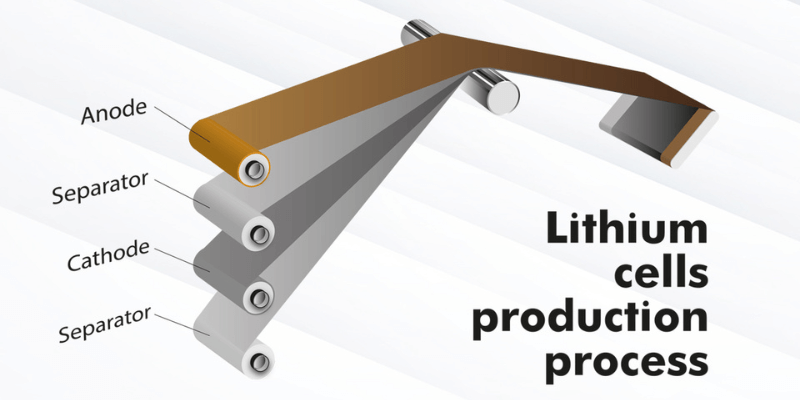
ชุดประกอบแบตเตอรี่
ทีนี้มาตรวจสอบว่าแบตเตอรี่ทำอะไรได้บ้าง
ผู้ผลิตเชื่อมเซลล์เข้ากับแผ่นทั้งด้านขั้วบวกและแคโทดจากนั้นประกอบเป็นแพ็ค พวกเขาทดสอบและจับคู่แพ็คเพื่อสร้างแอมป์ชั่วโมงที่ต้องการ
ถัดไปพวกเขารวบรวมแพ็คลงในเคสเชื่อมต่อกับ BMS และทดสอบแบตเตอรี่เต็มเพื่อความปลอดภัยและความน่าเชื่อถือ
ความสำคัญของคุณภาพการผลิต
การสร้างความมั่นใจว่าแบตเตอรี่ที่ปลอดภัยและมีประสิทธิภาพสูงต้องใช้กระบวนการที่เข้มงวด
แบตเตอรี่ลิเธียมมีความเสี่ยงด้านความปลอดภัยที่สำคัญเนื่องจากการผลิตที่ผิดพลาดหรือการใช้งานที่ไม่เหมาะสมสามารถกระตุ้นได้ หนีความร้อน – ไฟที่ยากที่จะดับ
แบตเตอรี่ Subpar ยังประสบปัญหาด้านประสิทธิภาพ
ดังนั้นจึงเป็นเรื่องสำคัญที่จะต้องได้รับผู้ผลิตแบตเตอรี่ที่เชื่อถือได้
ที่แบตเตอรี่ HOLO เรารักษามาตรฐานคุณภาพที่เข้มงวดทดสอบเซลล์และแบตเตอรี่ในระหว่างการผลิต ระบบการจัดการแบตเตอรี่ที่เป็นกรรมสิทธิ์ของเราป้องกันสภาพการทำงานที่เป็นอันตราย

คำถามที่พบบ่อย
แบตเตอรี่ลิเธียมรีไซเคิลได้หรือไม่?
แบตเตอรี่ที่ใช้แล้วสามารถนำกลับมาใช้ใหม่เพื่อนำลิเธียมกลับมาใช้ใหม่ได้ แต่กระบวนการยังคงใหม่ท้าทายและมีราคาแพง แบตเตอรี่ลิเธียมจำนวนมากยังไม่ถึงจุดจบของชีวิตดังนั้นการรีไซเคิลจึงยังไม่จำเป็น เนื่องจากแบตเตอรี่ต้องใช้การรีไซเคิลมากขึ้นการปรับปรุงกระบวนการจึงเป็นสิ่งสำคัญสำหรับอนาคตที่ยั่งยืนและเพื่อหลีกเลี่ยงการขุดทรัพยากรของโลก บริษัท ต่างๆกำลังค้นหาวิธีที่ดีกว่าในการใช้แบตเตอรี่ซ้ำ
แบตเตอรี่ลิเธียมไอออนสามารถระเบิดได้หรือไม่?
ใช่แบตเตอรี่ลิเธียมไอออนสามารถระเบิดได้ภายใต้เงื่อนไขบางประการเช่นการชาร์จมากเกินไปความร้อนสูงเกินไปข้อบกพร่องในการผลิตและความเสียหายภายนอก ดังนั้นมาตรการด้านความปลอดภัยในระหว่างการประกอบเช่นการเชื่อมเฉพาะและการรวม BMS จึงมีความสำคัญต่อการป้องกันความล้มเหลวของแบตเตอรี่
แบตเตอรี่ลิเธียมไอออนอยู่ได้นานแค่ไหน?
โดยทั่วไปแบตเตอรี่ลิเธียมไอออนสามารถใช้งานได้ 2 ถึง 5 ปีด้วยการใช้งานปกติ การดูแลที่เหมาะสมสามารถยืดอายุการใช้งานได้อีก
บทความที่เกี่ยวข้อง:

